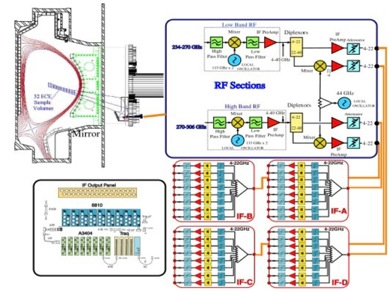The FRCECE system is unique due to its high frequency (234-306 GHz), large number of channels (32), high spatial resolution (~0.6 cm x 2 cm) and wide video bandwidth (1 MHz), which facilitates measurements of complete temperature profiles (full coverage of the low field side) with a toroidal field of 5.4 T and of fluctuation amplitudes. The diagnostic has been installed on a radial port of the Alcator C-Mod tokamak. It consists of a set of in-vessel collection optics that focus the ECE emission onto a set of overmoded waveguides that then carry the emission to the radio frequency receivers.

Two heterodyne receivers are used to cover the 80 GHz bandwidth. Each detects one of the bands (234-270 GHz and 270-306 GHz) which are then down-converted to 4-40 GHz bands, using the local oscillator frequencies of 115 GHz and 133 GHz (a frequency doubled 66.5 GHz LO), which then feed two second harmonic mixers. The mixer blocks have a net RF to IF gain of 10 dB, and employ an anti-parallel diode pair configuration to enhance the second harmonic mixing efficiency and eliminate the fundamental mixing response. The mixers are fed by an integrated diagonal feed horn structure coupled to a fundamental WR-4 waveguide machined into the mixer block. The IF signal from these mixers are split into 32 channels, band-pass filtered and detected using square-law detectors. The output of the detector is amplified by a video amplifier with a 1 MHz response and digitized. The wideband video amplifiers were developed at the University of Texas to reduce the cost of the IF section.
The ECE radiometer that UT-FRC provides for Alcator C-Mod yields 32 channels of high temporal and spatial resolution data on each shot. At 5.4 T, the most common field for C-Mod experiments, the channels cover the plasma from the magnetic axis to the lowfield- side separatrix. At lower fields, the measurement range shifts away from the magnetic axis but still provides measurements through the pedestal. At higher fields, the pedestal data is lost. An extension of the frequency range either to higher or lower frequency would benefit C-Mod experiments. We plan to increase the range of the measurements by extending the low end of the frequency range of the diagnostic.